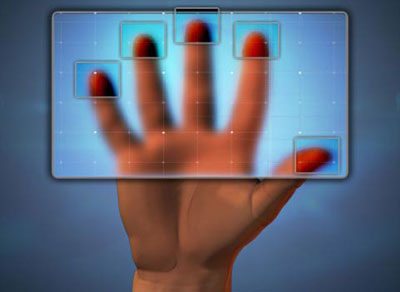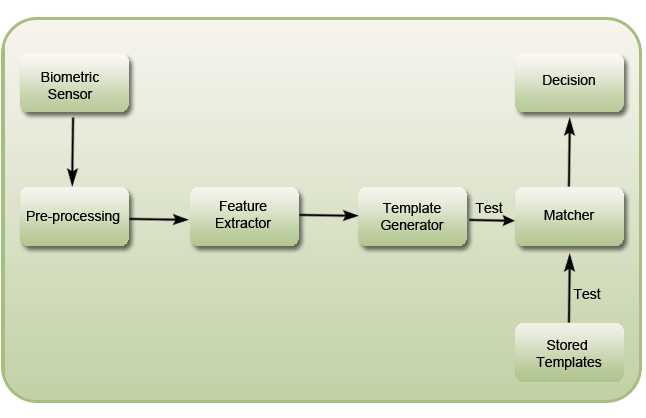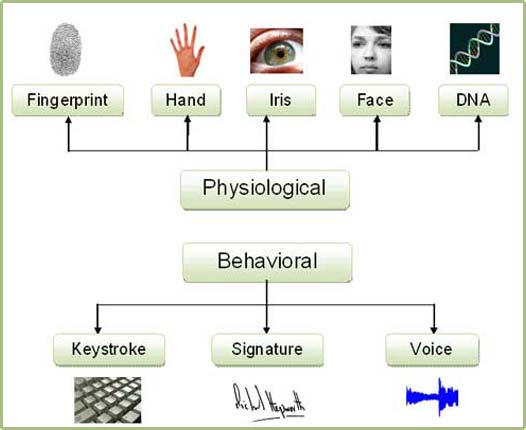Biometrics literally means life measurement and is associated with utilization of distinctive physiological characteristics for identifying individuals. Though most important application related with biometrics is that of security, it is used as the computer interface too. A range of Biometric applications are being used for authenticating person’s identity. With the use of various features including fingerprints, face, signature, and iris, a person is identified.

Fig. 1: A Representational Image Of Biometric Fingerprint Recognition Technology
Identification method using biometric characteristics is being preferred over conventional PIN and passwords based methods. Due to various advantages, biometrics technology is gaining popularity. The need of physical presence at the time of identification with these systems makes identification even more authentic. Use of this technology also overcomes necessity of remembering passwords and Pins. This automated technology thus makes verification and identification easier by identifying behavioral and physiological characteristics.
Fig. 2: An Overview Of Behavioral And Physiological Characteristics Used In Biometrics Technology
History
Chinese were the first ones to use biometrics in the 14th century. They used to take prints of feet and hands of the newborns to differentiate them from one another. Alphonse Bertillon introduced anthropometrical study called Bertillon age. This was known to be initial modern step for systematically identifying people with the use of biometrics. 11 different measurements were used by the system. These measurements identified the individuals with assumption that two individuals cannot be same. While the system proved to be flawed and cumbersome, basic concept stayed alive within law enforcement and scientific communities. This ultimately led to development of various biometric systems that are even used today.
Classification/Types
Biometrics can be divided into two groups based on purpose- verification and identification. Verification system is more popular among the two types. These biometrics banks on the database of the approved signatures prepared well in advance. System checks the signatures with already stored ones in the database to verify the identity. Identification systems try to determine exact identity of person. Instead of consulting local database, this type of biometrics system may use international database for determining the identity. Due to cost and complex nature, the identification systems are less popular.
Working
When someone uses biometrics for the first time, it’s called enrollment. In this stage, information is stored by the individual. In succeeding uses, information in biometric system is compared and detected with one stored in the enrollment. One should make sure that storage as well as retrieval of the information is done in a secure manner.

Fig. 3: Block Diagram Showing Different Functions Of A Typical Biometric System.
First block which is also known as sensor, acts as an interface between system and real world and acquires all necessary data. Usually it’s a picture acquisition system but can change as per desired characteristics. Second block performs needed pre-processing- removes artifacts from sensor, enhances input. In the following block, essential characteristics are extracted. This is a crucial stage as one needs to extract the right features in optimal way. Image or vector of the numbers with specific properties is used for creating template. Template is synthesis of related features extracted from source. Elements of biometric measurements those are not required for comparison algorithms are banished in templates for reducing size of file and for protecting identity of enrollee.
While the enrollment takes place, template gets stored in database or on card. And while matching process is performed, acquired template gets passed on to individual that is matching it with existing one, estimating distance between these two using the algorithm. Matching program evaluates template with input. This then becomes the output for specified purpose.
Applications
Attendance and time technology of biometrics is being used by a range of businesses for addressing deficiencies in the conventional attendance systems. The biometric technology restricts entrance of the unauthorized users and lets the authorized users in the property. It keeps record of all the entries and exists. Biometrics locks known as fingerprint locks are installed in homes for replacing the keys. System maintains database of approved fingerprints and lets only ones with fingerprints in record in the house. Other applications of this useful technology include biometric reports, security systems, biometric presentations and biometric whitepapers.
Why opt for Biometrics?
There are many benefits of using biometrics including better security. These systems offer low cost and convenient security tier. By using the biometrics, companies can also reduce the frauds related to buddy punching and ID. Biometric systems also take care of the problems related to forgotten passwords, lost IDs by employing physiological attributes. Companies can easily cut down password administration expenses and can replace difficult passwords too. Biometrics technology also provides increased ROI and cost savings in various areas including time and attendance and loss prevention.
Choosing the Biometrics Technology
There is a range biometrics system available in the market. It is important to pick one that suits user profile, interface requirements, application based parameters and environmental conditions. By keeping the following things in mind, one can pick the best biometric technology for use. Choose easy to use technologies unless you are trained for a specific type. It is also important to check the error incidence too. Environmental conditions and time affects accuracy of the biometric information. Vendors generally use two ways for measuring biometric accuracy. False rejection Rate and False acceptance rate are used for rating the accuracy of biometrics. So while buying the biometrics system, think about your requirements and then take an informed decision. Do not forget to analyze user acceptance and cost associated with the technology.
Technologies, Issues and Future
Emerging Technologies
A lot of companies, universities and inventors are continuously searching for frontier for upcoming biometric, showing prospects of being the best. Upcoming biometrics would have infancy stages of proved technology maturation. After proving themselves, following upcoming biometrics systems can become established systems too. DNA identification, Body salinity testing, Body odor detection, Gait recognition, ear pattern identification, Brainwave biometric and handgrip recognition are some of the emerging biometrics.
Issues and concerns
Though it is highly useful, there are certain limitations attached to the technology. One of the restraints of using the technology is cost involved in implementation and maintenance. Fingerprint scanning is not that a great option with elderly and ethical groups as their fingerprint quality is unsuitable for best results. Fingerprints keep changing, especially of those who are into manual labor with hands. Face recognition poses problems too. In case the user alters his/her hair styles, puts up or removes makeup, and then the system creates a problem. Retina systems are on their hand technically complicated. Another limitation of the biometric systems is privacy too as the data in system can be used without owner’s consent.
Future of biometrics
Future of this smart technology holds promise for the law enforcement purposes and for private industries too. Surveillance system can easily identify the suspects against features stored in database of security system. Biometrics are perceived as future of security industry and getting popular as accurate verification technology available in the market.
Future Biometrics will include ecommerce features for added security on checkout page and will also safeguard against unauthorized cell phones and car access. This technology will develop useful 3D facial recognition infrared access control, visitor management and face recognition surveillance. Already identification software, 3D face scanning, A4 Vision uses special algorithms for interpreting conventional 2D camera images and transfers it to 3D registered face representation. All this makes it impossible to mislead biometric systems with images and pictures. With new inventions in the field, future of biometrics is bright.
Filed Under: Articles



Questions related to this article?
👉Ask and discuss on Electro-Tech-Online.com and EDAboard.com forums.
Tell Us What You Think!!
You must be logged in to post a comment.